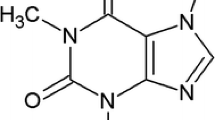Abstract
Caffeine has been found to display a low-temperatureβ- and a high-temperatureα-modification. By quantitative DTA the following data were determined: transformation temperature 141±2°; enthalpy of transition 4.03±0.1 kJ·mole−1; enthalpy of fusion 21.6±0.5 kJ·mole−1; molar heat capacity
in good accord with drop-calorimetric data. For the constants of the equation log (p/Pa)=−A/T+B, static vapour pressure measurements on liquid and solidα-caffeine, and effusion measurements on solidβ-caffeine yielded:
. The evaporation coefficient ofβ-caffeine is 0.17±0.03.
Résumé
La cafféine présente une forme basse température (β) et haute température (α). Les données suivantes ont été déterminées par ATD quantitative: température de transformation 141±2°, enthalpie de transition 4.03±0.1 kJ·mole−1, enthalpie de fusion 21.6±0.5 kJ ·mole−1, chaleur spécifique molaire
en bon accord avec les données obtenues par calorimétrie à chute. Les mesures sous pression de vapeur statique effectuées sur la cafféine liquide et solide (α) ainsi que les mesures d'effusion sur la cafféine liquide et solide (α) ainsi que les mesures d'effusion sur la cafféine solide (β) ont donné pour les constantes de l'équation lg(p/Pa)=−A/T+ B:
. Le coefficient d'évaporation de la cafféineβ est 0.17±0.03.
Zusammenfassung
Es wurde festgestellt, daß Caffein bei niedrigen Temperaturen eineβ- und bei hohen Temperaturen eineα-Modifikation besitzt. Durch quantitative DTA wurden folgende Angaben bestimmt: Umwandlungstemperatur 141±2 °C, Umwandlungsenthalpie 4.03±0.1 kJ·Mol−1 Schmelzenthalpie 21.6±0.5 kJ·Mol−1, molare Wärmekapazität
Sie stimmten gut mit den tropfkalorimetrischen Daten überein. Statische Dampfdruckmessungen an flüssigem und festemα- und Effusionsmessungen an festemβ-Caffein ergaben für die Konstanten der Gleichung lg(p/Pa)=−A/T+ B:
. Der Verdampfungskoeffizient vonβ-Caffein beträgt 0.17±0.03.
Резюме
Было найдено, что кофе ин существует в низкотемпературнойβ- и высокотемператур нойα- модификации. С помо щью количественного ДТА были определены такие пар аметры как температура прев ращения 141 + 2 °С, энтальп ия перехода 4.03±0.1 кдж· ·моль−1, энтальпия пл авления 21.6±0.5 кдж·моль− 1 молярная теплоемкос ть
которые хорошо согла суются с данными капе льной калориметрии. Измере ния паров жидкого и твердого, а т акже эффузионные изм ерения твердогоβ-кофеина по зволили определить констант ы уравнения lg(p/Пa)=−А/Т+В:
. Коэффициент испарен ияβ-кофеина равен 0.17±0.03.
Similar content being viewed by others
References
O. Eichler, Kaffee und Coffein, 2. Aufl., Springer, Berlin/Heidelberg/New York, 1976.
T. Ishii, Y. Kanzaki andK. Ishii, Yakuzaigaku, 26 (1966) 63.
W. W. Wendlandt, Thermal Methods of Analysis, Wiley, New York/Toronto, 1974, p. 421.
R. A. Baxter, inR. F. Schwenker andP. D. Garn, Thermal Analysis, Vol. 1, Academic Press, New York, 1969, p. 65.
P.Barberi, A.Paillet and Y.Machteau, IV. Symp. Europ. Fluor Chem., Ljubljana 1972; P.Barberi, Rev. Gén. de Thermique, 11 (1972) 124.
F. Grønvold, Rev. Chim., Min. 11 (1974) 568.
G. Adam andF. Müller, Kolloid-Z. Z. Polym., 192 (1963) 29.
I. Grabowska andR. Kaliszan, Acta Pol. Pharm., 29 (1972) 537.
J. Masse, R. Malaviolle, A. Chauvet, H. Massip andF. Sabon, Trav. Soc. Pharm. Montpellier, 34 (1974) 287.
P. S. Gabets, S. M. Reprintseva, N. V. Fedorovich andG. M. Volokhov, Khim.- Farm. Zh., 9 (1975) 23.
J. H. Stern andL. R. Beeninga, J. Phys. Chem., 79 (1975) 582.
We thank Dr. H.Klinge (Laboratorium Wärmetechnik, Phys.-Technische Bundesanstalt, Bundesallee 100, 33 Braunschweig) for the performance of the dropcalorimetric measurements.
A. Heiduschka andN. J. Meisner, Arch. Pharm. Ber. Dtsch. Pharm. Ges., 261 (1923) 104.
H. Cordes andH. Cammenga, Z. Physik. Chem. N. F., 45 (1965) 186.
G. W. Thomson andD. R. Douslin inA. Weissberger andB. W. Rossiter, Physical Methods of Chemistry Vol. 1, Part V, Wiley, New York/Toronto 1971, p. 74.
H. Cordes andH. K. Cammenga, Z. Physik. Chem. N. F., 63 (1969) 280.
Author information
Authors and Affiliations
Additional information
Part of this research was sponsored by Arbeitskreis Industrieller Forschungsvereinigungen Köln, under contract with Forschungskreis der Ernährungsindustrie e. V., Hannover.
We thank Drs. K. Sylla and J. Wilkens (HAG AG, Bremen) for stimulation of the present work and for discussions.
Rights and permissions
About this article
Cite this article
Bothe, H., Cammenga, H.K. Phase transitions and thermodynamic properties of anhydrous caffeine. Journal of Thermal Analysis 16, 267–275 (1979). https://doi.org/10.1007/BF01910688
Received:
Issue Date:
DOI: https://doi.org/10.1007/BF01910688



